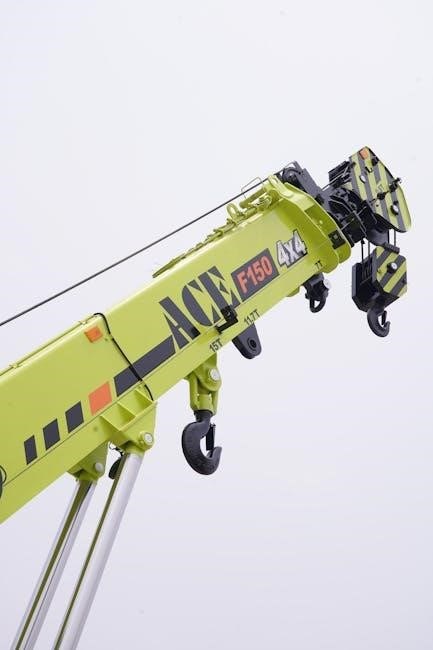The NFPA 704 standard provides a clear, diamond-shaped label system to identify hazards of materials for emergency response. It helps responders assess risks quickly and effectively, ensuring safety and proper mitigation strategies.
What is NFPA 704?
The NFPA 704 standard, developed by the National Fire Protection Association, provides a system for identifying hazards of materials for emergency response. It uses a diamond-shaped label divided into four sections: health, flammability, reactivity, and special hazards. Each section is color-coded and rated on a scale of 0-4, with 0 indicating no hazard and 4 representing severe danger. This system helps emergency responders quickly assess risks and take appropriate actions to ensure safety and effective mitigation.
Importance of NFPA 704 in Emergency Response
The NFPA 704 standard is crucial for emergency response as it provides immediate visual identification of hazards. Its diamond-shaped label offers critical information on health, flammability, reactivity, and special hazards, enabling responders to assess risks swiftly. This system ensures standardized communication, allowing emergency teams to make informed decisions quickly, which is vital for saving lives and mitigating dangers effectively. It also enhances responder safety by guiding appropriate protective measures and strategic actions during incidents.
Key Features of the NFPA 704 Standard
The NFPA 704 standard features a diamond-shaped label divided into four color-coded sections: blue for health hazards, red for flammability, yellow for reactivity, and a bottom section for special hazards. Each section uses a rating scale from 0 (no hazard) to 4 (severe hazard). The system also includes special symbols to indicate specific risks, such as oxidation or radioactive materials. This standardized approach ensures clear, quick communication of hazards, aiding emergency responders in making critical decisions effectively.

Components of the NFPA 704 Diamond
The NFPA 704 diamond consists of four color-coded sections: blue (health), red (flammability), yellow (reactivity), and a bottom section for special hazards.
Health Hazard (Blue Section)
The blue section of the NFPA 704 diamond indicates the level of health hazard posed by a material. Ratings range from 0 (no hazard) to 4 (severe or lethal). This section focuses on acute health effects, such as toxicity or corrosivity, that could occur during an emergency. Higher ratings signify greater risks to humans, guiding responders in taking appropriate protective measures. Chronic health effects are not included in this assessment. The blue section is critical for ensuring safe handling and response to hazardous materials.
Flammability Hazard (Red Section)
The red section of the NFPA 704 diamond represents the flammability hazard of a material. Ratings range from 0 (non-combustible) to 4 (highly flammable). A rating of 4 indicates substances that ignite easily and burn rapidly, posing significant fire risks. This section is crucial for emergency responders to assess fire dangers quickly and implement appropriate strategies to mitigate risks effectively.
Reactivity/Instability Hazard (Yellow Section)
The yellow section of the NFPA 704 diamond indicates the reactivity or instability hazard. Ratings range from 0 (stable) to 4 (highly unstable). A higher rating signifies materials that can explosively decompose or react violently with water, heat, or other substances. This section is vital for emergency responders to anticipate potential chemical reactions and take appropriate precautions to prevent or mitigate dangerous situations during incidents. Proper handling is crucial to avoid adverse reactions.
Special Hazards (Bottom Section)
The bottom section of the NFPA 704 diamond identifies special hazards using specific symbols. These symbols, such as W (reactive with water), OX (oxidizer), COR (corrosive), and others, provide critical information about unique risks. This section alerts emergency responders to hazards not covered by the numerical ratings, ensuring they take extra precautions. For example, W indicates a violent reaction with water, while OX warns of oxygen-releasing substances that can fuel fires. This section is essential for tailored emergency response strategies.
Classification Criteria for NFPA 704
The NFPA 704 standard classifies hazards based on health, flammability, and reactivity criteria, each rated from 0 to 4 to indicate severity levels for emergency response.
Health Hazard Ratings (0-4)
The health hazard ratings in NFPA 704 range from 0 to 4, indicating the severity of health risks posed by a material. A rating of 0 signifies no health hazard, while a rating of 4 indicates a severe, potentially lethal hazard. These ratings are based on acute health effects, such as toxicity and irritancy, providing critical information for emergency responders to assess personal protective equipment needs and medical response strategies effectively. This system ensures quick, informed decisions during emergencies.
Flammability Ratings (0-4)
The flammability ratings in NFPA 704 range from 0 to 4, indicating a material’s potential to ignite and sustain combustion. A rating of 0 means the material is nonflammable, while a rating of 4 signifies an extremely flammable substance that can ignite readily and spread fire rapidly. These ratings help emergency responders determine the appropriate tactics for controlling and extinguishing fires, ensuring a safer response to hazardous situations. This scale is critical for assessing fire risks and implementing effective mitigation strategies.
Reactivity/Instability Ratings (0-4)
The reactivity-instability ratings in NFPA 704 evaluate a material’s potential to undergo violent chemical reactions or become unstable under specific conditions. A rating of 0 indicates the material is stable, while a rating of 4 signifies an extreme risk of explosion or rapid reaction, even from minor disturbances; These ratings alert emergency responders to the need for specialized handling, such as avoiding heat sources or controlling environmental factors to prevent dangerous reactions. This classification is vital for ensuring safe and effective hazard mitigation strategies.

Special Hazards Designations
Special hazards are indicated on the NFPA 704 diamond to alert responders to unique risks, such as oxidizers (OXY) or corrosives (COR). These designations provide critical information for safe handling and mitigation during emergencies, ensuring responders are prepared for specific chemical behaviors.
Definition of Special Hazards
Special hazards in NFPA 704 refer to unique risks that require specific attention during emergencies. These hazards are denoted by symbols in the bottom section of the diamond, such as OXY for oxidizers or COR for corrosives. They indicate properties like unusual reactivity or the need for specialized equipment. These designations ensure emergency responders are aware of non-routine risks, enabling them to take appropriate actions to mitigate dangers effectively and protect people and the environment. This system enhances safety and preparedness in critical situations.
Examples of Special Hazard Symbols
Special hazard symbols in NFPA 704 include specific designations like OXY for oxidizers, COR for corrosives, and W for radioactive materials. These symbols alert responders to unique risks requiring specialized handling. For example, OX indicates oxygen reactivity, while ACID or ALK highlight strong acids or bases. These symbols ensure clear communication of extraordinary hazards, enabling targeted and safe emergency response actions to protect personnel and the environment effectively.

How to Read the NFPA 704 Diamond
The NFPA 704 diamond is read by identifying the four color-coded sections: blue (health), red (flammability), yellow (reactivity), and the bottom (special hazards); Each section provides critical hazard information to emergency responders, enabling quick and informed decision-making during incidents.
Step-by-Step Guide to Understanding the Label
To interpret the NFPA 704 diamond, start by locating the four colored sections: blue (health), red (flammability), yellow (reactivity), and the bottom for special hazards. Each section contains a number (0-4) indicating the hazard level. Begin with the health hazard (blue), which signifies the potential for injury or death. Next, assess the flammability (red) to determine how easily the material ignites; Then, review the reactivity (yellow) to understand its stability under stress. Finally, check the special hazards (bottom) for additional risks, such as chemical reactivity or unusual hazards. This systematic approach ensures emergency responders can quickly identify and mitigate risks effectively.
Interpreting the Numbers and Colors
The NFPA 704 diamond uses a color-coded system with numerical ratings (0-4) to communicate hazards. The blue section represents health risks, with 0 indicating no hazard and 4 signifying severe or lethal effects. The red section denotes flammability, ranging from non-flammable (0) to highly flammable (4). The yellow section indicates reactivity or instability, with 0 being stable and 4 highly unstable. The bottom section uses symbols for special hazards, such as chemical reactivity or unique risks. Understanding these elements ensures accurate hazard assessment for emergency response.

Application and Usage Guidelines
NFPA 704 labels are required on containers and at facility entrances to identify hazards. Label size varies based on distance, with a minimum of 8×8 inches indoors, ensuring visibility and quick hazard identification for emergency responders.
Where NFPA 704 Labels Are Required
NFPA 704 labels are mandated for facilities handling hazardous materials, ensuring clear hazard communication. They must be affixed to containers, storage areas, and facility entrances, with label size determined by viewing distance to ensure visibility. The minimum indoor label size is 8×8 inches, while larger labels may be required for outdoor or high-traffic areas. Proper placement of these labels is critical for emergency responders to quickly identify hazards and respond effectively.
Container Labeling Requirements
NFPA 704 labels must be prominently displayed on containers storing hazardous materials. The size of the label depends on the container’s size and the distance from which it will be viewed. The minimum label size is typically 8×8 inches for indoor containers, ensuring visibility. Labels must include the NFPA diamond with health, flammability, and reactivity ratings, as well as any special hazard symbols. Proper labeling ensures immediate hazard identification, aiding emergency responders in taking appropriate actions safely and efficiently.

Compliance and Legal Requirements
NFPA 704 compliance is enforced by regulatory bodies like OSHA and local fire departments. Adherence ensures safety and avoids penalties for non-compliance, maintaining legal and operational standards effectively.
Regulatory Bodies Enforcing NFPA 704
OSHA and local fire departments are primary enforcers of NFPA 704 standards. These bodies ensure compliance with labeling and hazard communication requirements to protect emergency responders and the public. Penalties for non-compliance can include fines and legal action. Regulatory enforcement emphasizes the importance of accurate hazard identification and consistent use of the NFPA diamond system. Staying updated with the latest standards is crucial for organizations to maintain compliance and operational safety effectively.
Penalties for Non-Compliance
Failure to comply with NFPA 704 standards can result in significant penalties, including fines and legal action. OSHA may impose substantial monetary penalties for violations of hazard communication and labeling requirements; In severe cases, non-compliance can lead to business shutdowns or criminal charges, especially if it contributes to accidents or injuries. Organizations must adhere strictly to NFPA 704 guidelines to avoid these consequences and ensure a safe working environment for emergency responders and employees alike.

Best Practices for Implementation
Training for Emergency Responders
Regular training ensures emergency responders understand and interpret NFPA 704 labels accurately, enabling effective and safe responses during incidents involving hazardous materials.
Comprehensive training on NFPA 704 is critical for emergency responders to quickly identify and interpret hazard information. This includes understanding the diamond’s color-coded sections, numerical ratings, and special symbols. Regular updates and hands-on exercises ensure responders remain proficient in assessing risks and implementing appropriate mitigation strategies during incidents involving hazardous materials. Effective training enhances response efficiency, safety, and overall incident management.
Regular Updates and Maintenance
Regular updates to the NFPA 704 standard are essential to reflect advancements in material hazards and response strategies. Emergency responders and facilities must stay informed about revisions, such as the 2022 edition, to ensure compliance and effective hazard communication. Maintenance involves periodic reviews of labeled materials, updating hazard ratings, and aligning with the latest regulatory requirements. This ensures the system remains accurate and reliable, supporting safer emergency operations and compliance with evolving safety standards.

Evolution of the NFPA 704 Standard
The NFPA 704 standard has evolved since its first edition in 1960, with periodic updates reflecting advances in hazard identification and emergency response. The 2022 edition incorporates modern safety practices, ensuring the standard remains relevant and effective in identifying material hazards. Updates align with global systems like GHS, enhancing its applicability and adoption worldwide.
Historical Development of the Standard
The NFPA 704 standard was first introduced in 1960, providing a standardized system for identifying material hazards. Over the years, it has undergone revisions to reflect scientific advancements and evolving emergency response needs. The 2022 edition incorporates updated hazard classification criteria, aligning with global systems like the Globally Harmonized System (GHS). This evolution ensures the standard remains a critical tool for emergency responders, offering clear and consistent hazard communication.
Recent Updates and Revisions
The latest edition of NFPA 704 (2022) includes updates to hazard classification criteria, ensuring alignment with global standards like the Globally Harmonized System (GHS). Revisions focus on clarifying reactivity and instability ratings, as well as enhancing special hazard designations. These changes improve the accuracy of hazard communication, aiding emergency responders in assessing risks more effectively; The updates reflect advancements in material science and emergency response practices, ensuring the standard remains relevant and reliable for modern applications.

Comparison with Other Hazard Identification Systems
The NFPA 704 system is a unique hazard identification method, differing from other systems like OSHA and GHS in its focus on acute hazards for emergency response scenarios.
OSHA Hazard Communication Standard
The OSHA Hazard Communication Standard (HCS) requires employers to inform workers about chemical hazards through labels, Safety Data Sheets (SDS), and training. Unlike NFPA 704, OSHA HCS focuses on workplace safety, ensuring employees understand chemical risks during daily operations, not just emergencies.
While NFPA 704 provides quick hazard identification for emergency responders, OSHA HCS offers detailed information for ongoing workplace safety. Both systems complement each other but serve distinct purposes and audiences.
Globally Harmonized System (GHS)
The Globally Harmonized System (GHS) is an international standard for classifying and communicating chemical hazards. It uses Safety Data Sheets (SDS) and pictograms to convey hazard information. Unlike NFPA 704, GHS focuses on a broader, global approach to chemical safety, addressing both health and environmental hazards. It provides detailed information for workplace safety and handling of chemicals.
GHS complements NFPA 704 by offering a standardized system for chemical classification and labeling, ensuring consistency worldwide. While NFPA 704 is primarily for emergency response, GHS targets ongoing chemical management and safety in the workplace.

Resources and References
Official NFPA 704 PDF documents are available on the NFPA website. Additional guides, such as the FREE NFPA GUIDE PDF, provide detailed explanations of the standard’s implementation and requirements.
Where to Find NFPA 704 PDF
The NFPA 704 PDF can be downloaded from the official NFPA website. Additionally, resources like the FREE NFPA GUIDE PDF are available for free download, offering comprehensive insights into the standard’s implementation. The document is also accessible through various online platforms, ensuring easy access for emergency responders, safety professionals, and organizations needing to comply with hazard identification requirements.
Additional Materials and Guides
Beyond the NFPA 704 PDF, numerous supplementary resources are available to deepen understanding and practical application. These include detailed guides, training materials, and case studies that provide real-world examples of hazard identification and response. Online courses and workshops also offer hands-on learning opportunities. Additionally, the FREE NFPA GUIDE PDF serves as a valuable companion document, offering practical insights and implementation strategies. These resources are essential for emergency responders, safety professionals, and organizations aiming to ensure compliance and effective hazard management.
The NFPA 704 standard is a critical tool for hazard communication, ensuring safety and effective emergency response. Its diamond labeling system and supporting PDF resources provide essential guidance for professionals.
The NFPA 704 standard provides a standardized system for identifying hazards of materials through a diamond-shaped label. It categorizes hazards into health, flammability, reactivity, and special hazards, each rated on a 0-4 scale. This system aids emergency responders in quickly assessing risks and implementing appropriate mitigation strategies. The standard is widely recognized and regularly updated to reflect current safety practices, ensuring accurate and reliable hazard communication. Its availability in PDF format makes it easily accessible for reference and training purposes.
Final Thoughts on the Importance of NFPA 704
The NFPA 704 standard is indispensable for ensuring safety and effective emergency response. Its diamond label system provides critical hazard information, enabling responders to act swiftly and appropriately. By standardizing hazard communication, it saves lives and reduces property damage. Regular updates ensure relevance, while the availability of the NFPA 704 PDF makes it accessible for training and reference. Compliance with this standard is essential for maintaining safety and meeting regulatory requirements in hazardous environments.
